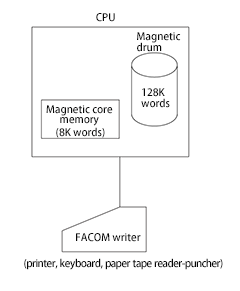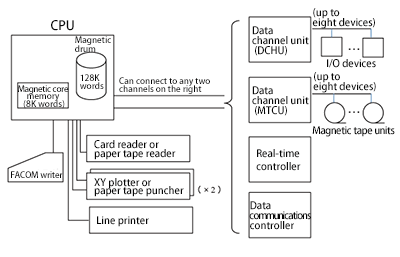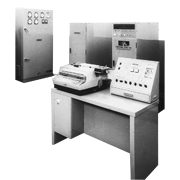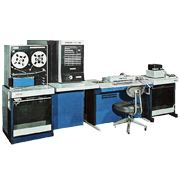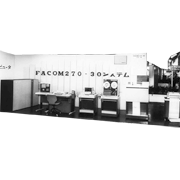Fujitsu announced the ultracompact FACOM 270-10 and the small FACOM 270-20, two models in its FACOM 270 series, in January 1965. Both models were completed in November 1965 and a third model, the mid-sized FACOM 270-30 completed in February 1968, was added later, rounding out the FACOM 270 series. The FACOM 270-20 was the core model of the 270 series, the 270-10 was designed to be an ultracompact version of the 270-20, and the 270-30 offered greater performance and capacity.
Fujitsu developed the series specifically for application fields such as small-scale scientific and engineering computing and real-time control processing (process control). At the time, small to mid-size computers, especially small computers, had become costly because their designs were overly focused on providing versatility. In contrast to this, the FACOM 270 series was developed around the concept that tailoring the design expressly for the applications fields above would result in small and inexpensive computers with performance levels in the particular fields that rivaled those of large general-purpose computers. The machines came with a real-time controller (RTC) for process-control applications. The RTC was a standard multi-purpose I/O coupler for the series and was developed from the ground up to support various analog I/O devices and digital I/O devices.
At the time of the FACOM 270-10 / 270-20 announcement, corporations in industries as far-flung as steel, cement, chemicals, electric power, and automobiles were transitioning from the exploration stage to the implementation stage of adopting computer-based process controls with an eye to raising productivity, improving quality, and automating production control. Thus, the FACOM 270 series’ development concept dovetailed neatly with the needs of corporations at that time.
The rest of this explanation concerns the FACOM 270-20, as it was the most popular model of the FACOM 270 series. See Table 1 for the functional differences between the three models.
| Model | 270-10 | 270-20 | 270-30 | |
|---|---|---|---|---|
| CPU | Technology | Discrete | Discrete | Monolithic ICs |
| Operation method | Binary serial | Binary parallel | Binary parallel | |
| Word length | 16 bits | 16/32 bits | 16/32 bits | |
| Main memory capacity (magnetic core memory) |
1K, 2K, 4K words | 4K, 8K, 16K, 32K words | 4K, 8K, 16K, 32K words | |
| Nunber of index registers | 3 | 3 | 3 | |
| Interrupt levels | 1 | 12 | 12 | |
| Internal magnetic drum memory capacity | — | 128K words | 256K words | |
| Data channels | — | 3 | 8 | |
| I/O devices | Magnetic tape unit | — | 15.0 – 96.0 KB/s 200, 556, 800 rpi | |
| Magnetic disk unit (capacity) | — | 33MB | 33—134MB | |
| Magnetic drum unit (capacity) | 32K words (two-byte words) | 256KB | 256KB—2MB | |
| Card unit | — | Reader: 100 – 800 cards/min. Puncher: 250 cards/min. |
||
| Line printer | — | 120 – 1,500 lines/min. | ||
| Paper tape unit | Internal unit Reader: 200 columns/min. |
Reader: 200 – 1,200 columns/min. Puncher: 100 – 200 columns/min. |
||
| Other devices | Typewriter | FACOM writer, XY plotter, data communications controller | ||
| RTC(Real Time Controller) | Connectable | Connectable | Connectable | |
In the mid-1960s, I/O data formats were moving from six-bit codes to eight-bit (one-byte) codes. Consequently, the FACOM 270-20’s architecture was based on 16-bit (two-byte) words because it is an integral multiple of eight. The FACOM 270-20 also had the following features.
- Operating system resides on an internal magnetic drum unit
- System extensibility
- Supplied with ALGOL, FORTRAN, and other software suited for the application field
- (1) Operating system resides on an internal magnetic drum unit
- System programs and programs for scientific and engineering calculations and real-time control processing were stored on a high-speed magnetic drum unit, so that the FACOM 270-20 was able to control priority processes quickly in response to interrupts and speed up its response times. Note that the ultracompact FACOM 270-10 did not have an internal magnetic drum unit. This was done because the FACOM 270-10’s applications were limited to process controls that could operate with the entire program placed in main memory.
- (2) System extensibility
- By focusing on specific application fields, the FACOM 270-20 was developed to be compact and inexpensive while delivering performance levels in the particular field that rivaled those of large general-purpose computers. To accomplish this, the FACOM 270-20 was designed with the extensibility to scale up from its very small basic configuration to meet even large usage conditions. Figure 1 shows the minimum basic configuration, whereas Figure 2 shows the largest system configuration available. The FACOM 270-20 was frequently used in university laboratories and for design work. In these applications, additional high-speed paper tape units, XY plotters, and line printers were often seen attached to the basic FACOM 270-20 system configuration.
As shown in Figure 2, FACOM 230 series’ disk units, magnetic drum units, card reader-punchers, paper tape reader-punchers, line printers, and magnetic tape units could be connected to the data channel unit (DCHU). The FACOM 603A, 603B, and 603D magnetic tape units, which were also connectable to FACOM 230 series machines, could be connected to the data channel unit (MTCU).


